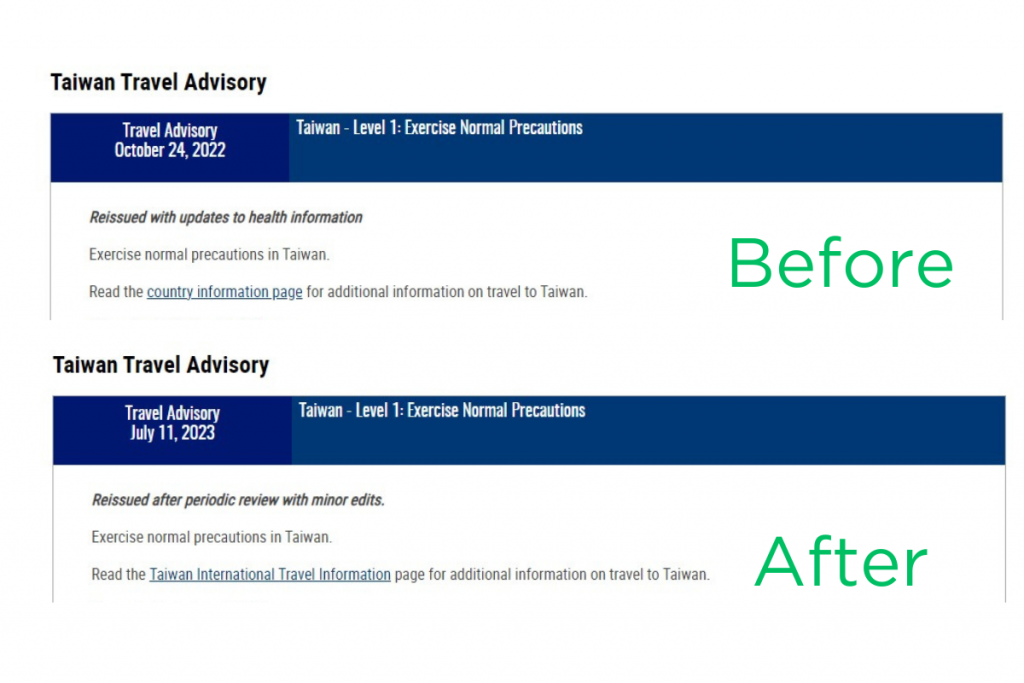The US State Department suddenly dropped the word ‘country’ from its travel advisory notice for Taiwan when China’s aggression against Taiwan became the major driver of tensions with the People’s Republic of China (PRC).
Russia Now Has ‘100% Protection’ Against US-Supplied HIMARS With Its Upgraded Defense System – Rostec
The website now features a “Taiwan international travel information” page instead of the “country information page” for Taiwan that the travel advisory previously pointed users to.
When contacted by Taiwan News to comment on the latest development, the spokesperson of the American Institute in Taiwan, considered the de facto embassy in the self-ruled island state, said that US policy on Taiwan remains unchanged without giving more specific details.
The spokesperson stated that the US state department updates its factsheets and webpages frequently, reflecting “longstanding, strong, bipartisan US support for Taiwan, in line with our One-China policy.” The US has been arming Taiwan to bolster its military capability in the face of rising Chinese aggression and intimidation in recent years.
China claims Taiwan as a renegade Chinese territory with “secessionist” forces ruling the island. The last couple of years have seen Beijing asserting this more strongly, vowing to unite Taiwan with the Chinese mainland, with force if necessary.
It has also increased military activity around the island, with recent military exercises serving as a reminder of its intentions.

The US continues to project force in the region and send subtle messages through its military activities in and over the contentious Taiwan Strait. For instance, on the third day of recent Chinese drills, a US Navy P-8A reconnaissance aircraft flew over the strait and was monitored by the PLA Air Force.
The US seventh fleet also regularly sends its destroyers to transit the strait under its Freedom of Navigation Operations (FONOPs).
The visit of the US House of Representatives speaker Nancy Pelosi to Taiwan in August last year aggravated tensions that refuse to abate even now. Going over and beyond all previous assertions for Taiwan, US President Joe Biden went so far as to say that his country would militarily support Taipei if Chinainvadedf the self-ruled island.
The US also continues to supply sophisticated military equipment to Taiwan, including the F-16 Viper fighter jets and the PAC-3 Patriot batteries. China has continued to condemn the US arms supplies to Taiwan, touting it as interference in China’s internal affairs and a violation of its sovereignty.
“The United States has ignored China’s core concerns, violently interfered in China’s internal affairs, and deliberately pushed up tensions in the Taiwan Strait,” a spokesperson for China’s Ministry of National Defense, Tan Kefei, said in a statement earlier this month.
Against that backdrop and an unrelenting backing of Taiwan at the expense of tensions with China in the region, the change in the travel advisory and deleting the word ‘country’ has certainly caught attention. Ironically, the official US position is that it does not recognize Taiwan’s independence under the One China principle.
America’s Official Taiwan Policy Favors China
The US government has always officially maintained that it adheres to the One China principle, which fundamentally contradicts Taiwan’s independence. Since 1972, the United States formally “acknowledged” Beijing’s claims that Taiwan is a part of China and that there is only one China.
When the United States decided to de-recognize the Republic of China (ROC) and recognize the People’s Republic of China (PRC) in 1979, it declared that the PRC government was “the sole legal Government of China.” In this context, “sole” refers to the PRC as only China, with the ROC not considered a separate sovereign state.
However, despite Chinese pressure, the United States refused to acknowledge Chinese rule over Taiwan, which is what it prefers to be called since it chose to de-recognize the ROC. On the other hand, Washington accepted Beijing’s stance that Taiwan was a part of China.
Owing to their respective geopolitical interests of the time, the United States and the PRC were both eager to move through with diplomatic recognition.
Moreover, the US Congress came up with the Taiwan Relations Act (TRA) in 1979 to safeguard the major US security and commercial interest in Taiwan. Without formal diplomatic relations, the TRA offered a framework for ongoing cooperation.
The “Six Assurances,” announced in 1982 and ratified by the US government in 2016, also govern relations between the US and Taiwan. They provided reassurance that the US had not decided to stop arming Taiwan or change the Taiwan Relations Act, and they defined the country’s position on Taiwan.
After all, the news about deleting the word country from the travel advisory page may not be an aberration. Taiwan is no longer referred to as a country on the state department’s other pages about US-Taiwan ties and hasn’t been since at least 2019. However, a 2022 study of Taiwan’s human rights record was called a “Country Report.”
Except for the State Department’s website, most US government websites normally do not refer to Taiwan as a country, except the CIA, which does so throughout its World Factbook profile.
On being probed about the development, Taiwan’s Foreign Ministry stated they had nothing to say about the decision. However, the ministry reasserted that theirs was an independent and democratic country.
“The Republic of China (ROC) and the People’s Republic of China (PRC) are not subordinate to each other, and the future of the ROC, Taiwan, must follow the will of all Taiwanese people,” which is similar to the language that the island state uses to describe issues related to its sovereignty.
- Contact the author at sakshi.tiwari9555 (at) gmail.com
- Follow EurAsian Times on Google News